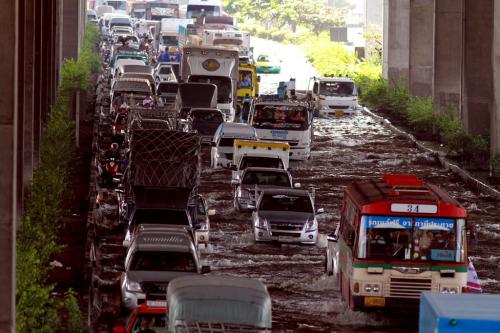Deluge heading to Rangsit

Governor warns run-offs from North coming towards capital faster than expected. About 1.2 billionn cubic metres of water expected to sweep around Rangsit Canal.
A massive run-off from the North is bearing down on Bangkok faster than expected and should reach Rangsit Canal tonight, Governor Sukhumbhand Paribatra said yesterday.
During his third press conference of the day, as part of his updates every three hours, he said all the sluice gates of Canals 1-12 were opened. The water from submerged Nava Nakorn Industrial Estate would arrive first followed by the water from Rapeepat Canal.
The flood is expected to surge into Canal 2 and Hok Wa Canal, the frontline defence of the capital, tomorrow.
Sukhumbhand earlier urged 200 households along Hok Wa Canal to seek shelter at Ritthiyawannalai 2 School, which could accommodate 1,000 people. H also told residents in seven at-risk districts to move their belongings and electric sockets to higher elevations and prepare for evacuation.
The seven districts are Sai Mai, Bang Khen, Khlong Sam Wa, Nong Chok, Min Buri, Lat Krabang and Khan Na Yao.
He said 1.2 billion cubic metres of water were expected to sweep over areas around Rangsit Canal, which could handle only 400 million cubic metres.
Prime Minister Yingluck Shinawatra said construction of flood barriers along Rangsit-Pathum Thani Road north of Bangkok has almost been completed
Citing Defence Minister Yuthasak Sasiprapha, she said some sections remained unfinished along the entire 17-kilometre stretch but the work by Army engineers was continuing.
Within 24 hours, floodwater from Pathum Thani will possibly pass through these new barriers, but she did not say whether they would be ready in time before the water arrived.
The government and the Bangkok Metropolitan Administration will jointly build a flood barricade along the Outer Eastern Ring Road, starting from the Phra In sluice gate north of Bangkok, to divert the flow eastwards to Nakhon Nayok and Chachoengsao, Yingluck said.
She was speaking after meeting with Justice Minister Pracha Promnok, who is in charge of the Flood Relief Operations Centre, and Sudarat Keyuraphan, an executive of the now-defunct Thai Rak Thai Party.
An aerial survey of the Rapeepat, 1-12, Rangsit and southern Hok Wa canals found the dykes at about one foot above water level and breaches here and there along the Rapeepat Canal dykes.
About 8 billion cubic metres of runoff remained in Rangsit, Bang Pa-in and the Ayutthaya, Pathum Thani and Bangkok boundaries, while 300 million cubic metres could be drained daily through the Chao Phraya River, 26 million cubic metres to the east of Bangkok and 60 million cubic metres of water to the west.
Residents in southern Rangsit Canal communities protested against the opening of their sluice gate, so only the gates of Canals 3,4 and 8 could be opened. The water in Canal 6 rose and exceeded the level in the Rapeepat Canal, which was a critical point as the last gate to the inner city.
Ratchapon Boonrawd, deputy chief of Bangkok’s Sai Mai district, said six-kilometre-long sandbag walls had already been laid along Canal 2 and Hok Wa Canal. The dykes would be reinforced although the roads along the canal would be closed.
The district had prepared many places for vehicle parking, he said.
Anudith Nakornthap, the MP for Sai Mai district and also the information and communications technology minister, said the drainage of floodwater from the North was being managed with the aim to best protect Bangkok without political interference. For eastern areas, the Engineering Institute of Thailand would inspect the floodwalls protecting the Lat Krabang Industrial Estate to make sure they are strong, he said after meeting with Justice Minister Pracha and Sudarat.
Chuchart Supawattanangkul, who is responsible for North Rangsit irrigation maintenance and water distribution, said a huge volume of water was rushing through the Khlong Luang and Thanyaburi districts of Pathum Thani and would definitely overwhelm Rangsit Canal.
Then the water would wash through areas in Bangkok as the dykes around the Chulalongkorn sluice gate were not as sturdy as the broken barrier of Rapeepat Canal in Khlong Luang district. The current was running at about 70 cubic metres per second, which was considered huge, he said.
About 40 metres of the dyke along Rapeepat Canal, around Canals 4 and 5, were breached late Tuesday evening, letting torrents stream across the road, which lies below and along the canal, then inundating over 50-60 households in downstream communities. Repair of the dyke was made difficult by the strong currents and emergence of the breach, said Charn Puangpetch, president of the Pathum Thani Provincial Administration Organisation.
